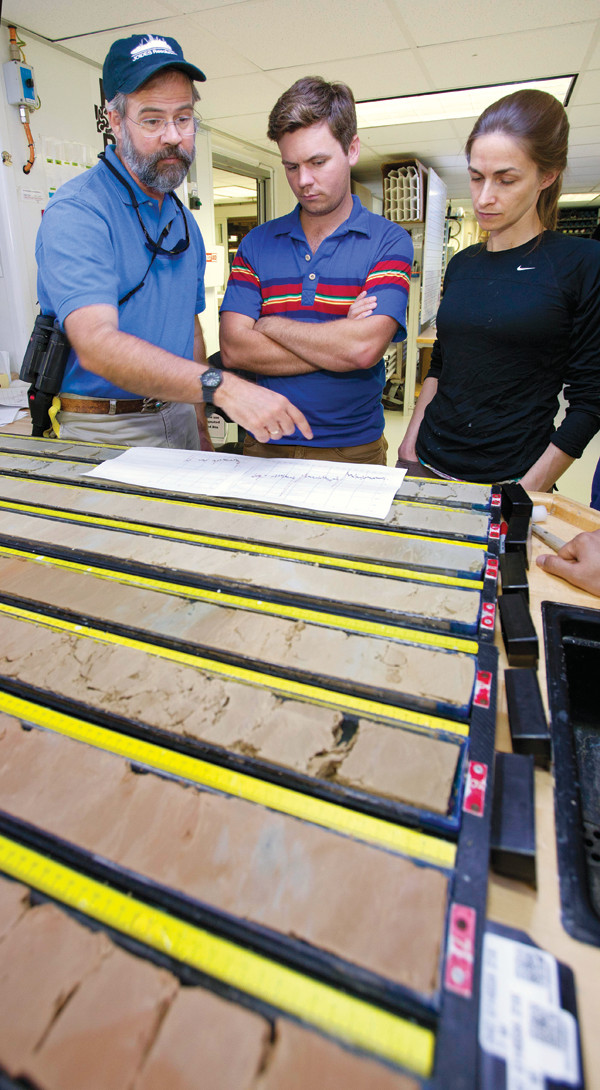
by Allison Mills Tuesday, September 2, 2014

Aboard the drillship JOIDES Resolution, Don Penman and colleagues examine ocean floor sediments containing geochemical clues about the Paleocene-Eocene Thermal Maximum. Credit: John Beck.
Pockmarked plankton shells and dead coral are becoming the hallmark images of ocean acidification. But this isn’t the first time seawater has dropped on the pH scale. Based on models of seawater chemistry, the ocean acidity during the Paleocene-Eocene Thermal Maximum (PETM), beginning about 56 million years ago, is the closest-known analog to today. Now, researchers using boron proxies preserved in microfossils to reconstruct surface-ocean chemistry suggest that acidification was more extensive and lasted longer than previously thought, although the PETM conditions still don’t outpace the current rate of ocean acidification.
Ocean acidification occurs when seawater takes up increasing amounts of atmospheric carbon dioxide. This creates carbonic acid and lowers the water’s pH. To measure the pH of ancient seas, researchers turn to proxies embedded in fossils of microscopic foraminifera (forams) and other organisms buried in ocean sediments, ideally in places where the layers are relatively undisturbed. Carbon is the most common proxy, but in a new study published in Paleoceanography, researchers have turned to boron.
“Experiments with living forams and recently buried forams show that they document the pH of the water that they live in with these boron proxies,” says Donald Penman, a paleoceanography graduate student at the University of California at Santa Cruz, and lead author of the study. “This is probably one of the first applications of this proxy to deep time,” he says.
The team assessed boron isotopes in PETM foraminifera; lower proportions of boron-11 relative to boron-10 correspond to lower pHs. To verify the pattern observed in the isotopes, the team also measured boron-to-carbon ratios. The team confirmed that not only was there acidification — resulting in a drop of 0.3 pH units, or about a doubling of acidity — but also that it lasted longer than expected.
“The boron isotope shift provides robust evidence for a change in ocean pH, and the boron-to-carbon record provides additional, intriguing clues to carbon cycle changes occurring at one of the most dramatic climate events of the Cenozoic,” says Katherine Allen, a paleoceanographer at Columbia University’s Lamont-Doherty Earth Observatory who was not involved with the study.
Past studies have documented a major carbon cycle disruption at the beginning of the PETM, which could have lasted up to 10,000 years. Models using only a single pulse of carbon have suggested acidification lasted about as long. With the new boron proxy data, however, Penman’s team found acidification stretched on for 70,000 years.
Previously, the only model calculations to support that long duration were based on both a big initial pulse of carbon followed by a sustained release of carbon. The sustained acidification observed in the PETM could mean geochemical feedbacks prevented the climate system from recovering in a timely manner, Penman says.
This study is the “first dataset that actually constrains, with proxy data, the surface-water ocean acidification” during the PETM, says Samantha Gibbs, a paleoceanographer from the University of Southampton in England who was not involved with the study. Those constraints help researchers understand how acidification will affect biota in today’s oceans. But the PETM-modern parallel isn’t exact, both Gibbs and Penman say.
“Our study shows that the rate of carbon emissions and resulting acidification [during the PETM were] an order of magnitude slower than what’s going on right now,” Penman says. Modern organisms are dealing with the same magnitude of change on a much shorter time line.
Even if it’s not an exact how-to guide, continuing research on marine life’s reactions to the PETM is important, Penman says, and the new application for boron proxies has promise to help make the related geochemical processes clearer.
Gibbs says that there are “teething problems” with any new technique, especially a proxy, but boron proxy data has the potential to expand researchers’ knowledge of PETM oceans. “As a community,” she adds, “I’d say we’re pretty upbeat about boron.”
© 2008-2021. All rights reserved. Any copying, redistribution or retransmission of any of the contents of this service without the expressed written permission of the American Geosciences Institute is expressly prohibited. Click here for all copyright requests.